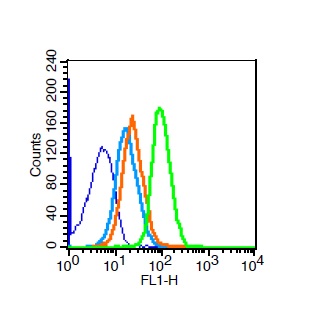![NGFR (Nerve Growth Factor Receptor)(NTR/912), CF405S conjugate, 0.1mg/mL [26628-22-8] NGFR (Nerve Growth Factor Receptor)(NTR/912), CF405S conjugate, 0.1mg/mL [26628-22-8]](https://biotium.com/wp-content/uploads/2016/12/BNUB0912-0-1.jpg)
NGFR (Nerve Growth Factor Receptor)(NTR/912), CF405S conjugate, 0.1mg/mL [26628-22-8]
BNC040912
ApplicationsImmunoHistoChemistry, ImmunoHistoChemistry Paraffin
Product group Antibodies
ReactivityBovine, Human, Mouse, Primate
TargetNGFR
Overview
- SupplierBiotium
- Product NameNGFR (Nerve Growth Factor Receptor)(NTR/912), CF405S conjugate, 0.1mg/mL [26628-22-8]
- Delivery Days Customer9
- ApplicationsImmunoHistoChemistry, ImmunoHistoChemistry Paraffin
- CertificationResearch Use Only
- ClonalityMonoclonal
- Clone IDNTR/912
- Concentration0.1 mg/ml
- ConjugateOther Conjugate
- Gene ID4804
- Target nameNGFR
- Target descriptionnerve growth factor receptor
- Target synonymsCD271, Gp80-LNGFR, TNFRSF16, p75(NTR), p75NTR, tumor necrosis factor receptor superfamily member 16, NGF receptor, TNFR superfamily, member 16, low affinity neurotrophin receptor p75NTR, low-affinity nerve growth factor receptor, low-affinity nerve growth factor receptor p75NGFR, low-affinity nerve growth factor receptor p75NGR, p75 ICD
- HostMouse
- IsotypeIgG1
- Protein IDP08138
- Protein NameTumor necrosis factor receptor superfamily member 16
- Scientific DescriptionThis antibody recognizes a glycoprotein of 75 kDa, identified as low affinity Nerve Growth Factor (NGF) Receptor (p75NGFR) or Neurotrophin Receptor (p75NTR). NGFR is expressed in various neural crest cells and their tumors such as melanocytes, melanomas, neuroblastomas, pheochromocytomas and neurofibromas. Reportedly, anti-NGFR is a reliable marker for desmoplastic and neurotropic melanomas. NGFR is expressed in mature non-neural cells such as perivascular cells, dental pulp cells, lymphoidal follicular dendritic cells, basal epithelium of oral mucosa and hair follicles, prostate basal cells, and myoepithelial cells. Anti-NGFR stains the myoepithelial cells of breast ducts and intra-lobular fibroblasts of breast ducts. Primary antibodies are available purified, or with a selection of fluorescent CF® Dyes and other labels. CF® Dyes offer exceptional brightness and photostability. Note: Conjugates of blue fluorescent dyes like CF®405S and CF®405M are not recommended for detecting low abundance targets, because blue dyes have lower fluorescence and can give higher non-specific background than other dye colors.
- SourceAnimal
- ReactivityBovine, Human, Mouse, Primate
- Storage Instruction2°C to 8°C
- UNSPSC12352203

![NGFR (Nerve Growth Factor Receptor)(NTR/912), CF405S conjugate, 0.1mg/mL [26628-22-8] NGFR (Nerve Growth Factor Receptor)(NTR/912), CF405S conjugate, 0.1mg/mL [26628-22-8]](https://biotium.com/wp-content/uploads/2016/12/BNUB0912-1-1.jpg)





